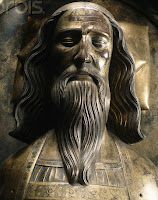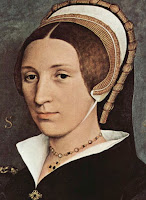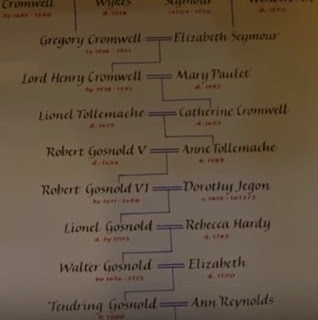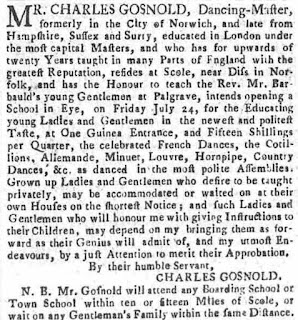 |
| Danny Dyer at Otely Hall, Suffolk |
The episode is (as are all the WDYTYA episodes) very engaging and well-produced. Danny was born and raised in London's East End, and the twist is his discovery that he is descended from Thomas, Lord Cromwell, Henry VIII's notorious right-hand-man, and also from Edward III of England. In blue jeans and leather jacket, a Cockney version of historian Dan Jones, Dyer travels to the oldest pub in Oxford, to the grand Suffolk manor house of Otley Hall (“I think it’s the most beautiful house I’ve ever seen”), to the even grander manor house of Helmingham Hall, family seat of the current Baron Tollemache, who makes an appearance ("This geezer's got a drawbridge"), to Hampton Court Palace, where he meets with delightful Cromwell historian Tracy Borman (“You could have a right rave in ’ere couldn’t you babe, eh?”), to, finally, Westminster Abbey, where Peter O'Donoghue, York Herald from the College of Arms, shows him the tomb of Edward III (“My blood is his blood, I can’t compute it in my brain”). It's a hit on social media, where many are saying it's the best-ever WDYTYA episode.
 |
| Edward III (1312-1377) |
Edward III had a 2nd surv son,
1) Lionel of Antwerp, 1st Duke of Clarence (1338-1368) m. 1) Lady Elizabeth de Burgh (1332-1363, descended from Edward I), and had
2) Lady Philippa Plantagenet of Clarence (1355-1377) m. Edmund Mortmer, 3rd Earl of March (1352-1381), and had
 |
| Elizabeth (née Seymour), Lady Cromwell - see Generation 8 |
4) Lady Elizabeth Percy (c.1395-1437) m. 1) John, 7th Lord Clifford (1388-1422, descended from Edward I), and had
5) Mary Clifford (c.1420-by1458) m. Sir Philip Wentworth of Nettlestead (1424-1464), and had
6) Sir Henry Wentworth of Nettlestead (1448-1499) m. 1) Anne Say (c.1448-aft.1489), and had
7) Margery Wentworth (c.1478-1550) m. Sir John Seymour of Wolf Hall (c.1474-1536), and had
8) Elizabeth Seymour (c.1514-by 1563) m. 2) Gregory, 1st Baron Cromwell (c.1514-1551, son of Thomas, Lord Cromwell), and had
9) Henry, 2nd Baron Cromwell (1538-1592) m. Lady Mary Paulet (c.1540-1592, descended from Edward III), and had
 |
| Lady Katherine (née Cromwell) Tollemache - see Generation 10 |
[Notes: These first ten generations are well-covered in the peerage works. Sir Lionel Tollemache and Katherine Cromwell were third cousins, both descended from Sir Henry Wentworth - Generation 6 above.]
11) ANNE TOLLEMACHE, bap. 9 Nov. 1589 St Mary Church, Helmingham; d. unknown; m. 1st 20 Feb. 1609 St Mary Church, Helmingham, ROBERT GOSNOLD of Otley Hall, b. c.1587; d. by 1635, son of Robert Gosnold, Heir of Otley Hall (d. 1596, descended from Edward I) and Amy Forth (1568-aft.1631, descended from Edward I), and had
[Notes: Anne was the youngest of five daughters, and basically married the boy next door: Otley Hall is only two miles from Helmingham Hall. After his death, she m. 2nd 20 Aug. 1635 St Peter & St Paul Church, Pettistree, Suffolk, Samuel Blennerhassett of Loudham Hall, Pettistree (1602-1640, descended from Edward I). She was mentioned as living in the codicil (dated 18 Nov. 1656) to the will of her eldest son Robert Gosnold. I haven't located a burial entry, or a will, for her. With Robert Gosnold she apparently had five sons and two daughters: Robert, Gregory, Lionel, Sackford, Henry, Anne (wife of Thomas Hovell) and Susan (wife of Wheeler).]
 |
| Gosnold of Otley coat of arms [Per pale crenelle or and azure] |
[Notes: The WDYTYA episode goes into much detail about Col. Gosnold. His wife Dorothy had a bishop for a father, and another for a grandfather: her mother was the daughter of Rt Rev. Richard Vaughan, bishop of London. The date of Dorothy's 1671 will is mentioned in some online sources, but it doesn't appear that her will has ever been transcribed or abstracted. Col. Gosnold and his wife had eight verifiable children: Robert (d. by 1668), Lionel (living 1673), Charles (living 1663), Edward (d. 1673), Sackford (living 1673), Dorothy (d. 1678, wife of Michael Griggs of Little Bealings, Suffolk), Elizabeth (living 1651), and Rachel (living 1692, wife of John Girling).]
13) Rev. LIONEL GOSNOLD, Rector of Boyton 1664-74, of Otley 1674-1703, of Barham 1693-1703, Vicar of Framsden 1669-82, b. c.1640; d. 11 Feb. 1703; m. 1675 St Peter Church, Palgrave, Suffolk, REBECCA HARDY, b. c.1655; bur. 23 May 1742 All Saints Church, Stuston, Suffolk, and had
 |
| Distant cousins Danny Dyer and Lord Tollemache meet up at Helmingham Hall |
 |
| St Mary Church, Framsden, Suffolk |
[Notes: Walter is of the first generation of Gosnolds to have been born without landed gentry status. However, the name of Gosnold would have carried weight and respectability in the county, and as the second son of a clergyman, he could have his choice of profession. A career in the church seems a natural path to have taken, but his elder brother Lionel chose law instead, while Walter chose medicine. Fortunately, Walter's P.C.C. will (written 20 Feb. 1712/3, codicil 13 May 1713, proved 2 Aug. 1718) survives, and is the proof that the Ipswich surgeon was the same Walter, son of Rev. Lionel and Rebecca Gosnold. For in the codicil to his will, Walter gives his lands (in Witnesham and Tuddenham, Suffolk, and in Great Leighs and Little Leighs, Essex) "after the death of Tendring my son, in case he shall die without issue and within the age of one and twenty years, unto and amongst my brother Charles and sisters Dorothy, Mary, Abigail and Elizabeth equally as tenants in common and to their heirs forever." Several online pedigrees which pre-date the WDYTYA episode, show Walter's wife as Elizabeth, who died 1700, and she is included in the charts presented to Danny. Whatever evidence exists to assign Walter Gosnold such a wife, it's not available online: I can't find a marriage entry for Walter, nor a burial entry for an Elizabeth Gosnold near to the date of 1700. It's clear from Walter's will that his son Tendring was his only child - it's not clear from that document whether or not Tendring was legitimate. Update 9/12/17: Tendring was legitimate. Many thanks to genealogist Christine Brunsden, who shared with me the baptism entry for Tendring Gosnold, and the burial entry for his mother Elizabeth, which she uncovered in Colchester, Essex]
 |
| St Peter Parmentergate, Norwich |
[This is the generation that is the weakest link in the line of descent - there is no direct evidence that Tendring Gosnold had a son named Charles. 'Tendring' is an interesting and unique first name: it's possible it points to a birth in Essex, where his father Walter held lands, or that it was the maiden name of his mother, of whom we know nothing. In Walter Gosnold's will he assigns profits from the rents on his lands to be applied "toward the maintenance, better education and binding[?-the word is difficult to make out] out of the said Tendring Gosnold an apprentice." Walter had also bequeathed to his only son "all the books and instruments of my profession," perhaps with the hope he would follow in his footsteps and become a surgeon. If so, his hope didn't materialize, for in 1716, three years after his father's death, Tendring, son of Walter Gosnold of Ipswich, was formally apprenticed to Thomas Barett, wool weaver, of Norwich. Other than his 1723 marriage entry and the baptism entries for his following five children in the parish registers -- 1) Tendring Gosnold (bap. 12 Sept. 1725 St Giles Church, Norwich; bur. 8 Oct. 1726 St Peter Parmentergate); 2) Anne Gosnold (bap. 21 July 1726 St Simon & St Jude Church, Norwich; bur. 29 July 1726 St Peter Parmentergate); 3) & 4) twins Tendring and Anne Gosnold (bap. 20 June 1727 St Simon & St Jude Church, Norwich; both bur. three days later 23 June 1727 St Peter Parmentergate); 5) Anne Gosnold (b. 12 May 1728, bap. 5 June 1728 St Michael at Plea Church, Norwich) -- Tendring Gosnold cannot be found in online genealogy indexes.
 |
| Portion of the scroll given to Danny Dyer by York Herald |
16) CHARLES GOSNOLD of Norwich, dance instructor, b. 1730/1 (aged 57, per burial entry); bur. 9 Apr. 1788 St Peter Parmentergate, Norwich; m. 13 May 1753 St John the Baptist Church, Maddermarket, Norwich, SARAH FRENCH, b. c.1732 (age 75 at death, per her M.I.); d. 31 Mar. 1807 Norwich, bur. 5 Apr. 1807 St Peter Parmentergate, and had
[I'm willing to take the leap of faith that this Charles was a son of Tendring Gosnold. Lack of a baptism entry is frustrating, but in 1752 in Norwich, Charles son of Ann Gosnold, was apprenticed to Nicholas Norgate, weaver. Given that there seem to be very few Gosnolds in Norwich in this period, and that Tendring Gosnold was himself a weaver, it's very likely that Charles was his son. The weaver apprenticeship doesn't seem to have lasted long, because apparently what Charles really wanted to do was dance.
 |
| Charles Gosnold's Advertisement in Norfolk Chronicle July 25, 1778 |
17) ANNE GOSNOLD, b. c.1768 (age 75 at death, per her burial entry); d. 31 May 1843 Bracondale, Norwich, bur. 8 June 1843 St Peter Parmentergate; m. 6 Mar. 1788 St Lawrence Church, Norwich, JAMES BUTTIVANT of Kennington, Surrey, merchant trader at East India House, London, b. c.1761 (aged 63 at death) Norwich; d. 11 May 1824 Kennington, bur. 19 May 1824 St Mary Church, Lambeth, Surrey, son of James Buttivant of St George's, Tombland, Norwich, master weaver (c.1740-1793) and Mary Walker (1739-1787), and had
 |
| Norwich Market Place in 1806 |
 |
| John Henry Buttivant tomb, Old Protestant Cemetery, Macau [Image from Find a Grave] |
18) CHARLES BUTTIVANT of London, coal merchant/clerk, b. 15 Sept. 1804 Norwich, bap. 16 Sept. 1804 St Michael at Plea Church, Norwich; d. (suicide) 10 July 1865 No. 4 Dean Street, St George in the East; = (common law marriage) c.1850, HANNAH SARAH WING, laundress, b. c.1826 Stepney, London; d. 1909 Islington, London, and had
 |
| One of the pedigree charts used in the episode |
 |
| High Street, Whitechapel, mid-19th-century |
 |
| Albert & Ann (née Howcutt) Buttivant - see Generation 19 |
The most heartbreaking testimony came from Charles and Hannah's 18-year-old eldest daughter, Hannah Martha Buttivant (1847-1939): "The deceased was my father. He was a shipping clerk. He had latterly been very desponding in consequence of the reduced circumstances of his family. On Monday last I found him lying upon the bed in his room, groaning. There was a smell of bitter almonds in the room, and I said, 'Father, you have taken the bitter almonds!' He said to his youngest child, who was seated on the bed near him, 'Don't cry, dear.' I again spoke to him, and said, 'I cannot remain and see you suffering thus. I will go and call ma.' He gave a groan and exclaimed, 'Oh, my God!' He died in half an hour in the presence of three doctors. He had been given the bottle of bitter almonds at the docks by a person who brought it with him to this country from a chemist in Port Adelaide" [Ibid]. The jury at the inquest returned a verdict that the deceased took his own life in a state of temporary mental derangement. Hannah Wing kept the Buttivant surname and the public status as Charles's widow for the rest of her long life. She married off all three of her daughters, and continued to hold her family together as a single mother in the East End working as a laundress. She died in the London suburb of Islington in 1909 at age 83.]
19) ALBERT BUTTIVANT of Poplar, London, cigar maker, labourer, b. 4 Nov. 1851 Whitechapel, London, bap. 28 Dec. 1856 St Botolph Without Aldgate; d. 19 Mar. 1935 Poplar; m. 1871 Bethnal Green, Stepney, ANNE HOWCUTT, washerwoman, b. 23 Feb. 1849 Stepney, bap. 12 Feb. 1862 St Dunstan Church, Stepney; d. 1933 Poplar, dau. of William James Howcutt of Mile End, blacksmith (c.1819-1883) and Emma Brown (1817-1898), and had
[Notes: Charles Buttivant's suicide in 1865 would have haunted all of his children, but it seemed to take a particularly hard toll on 14-year-old Albert, his eldest son from his second wife Hannah. Though one of Charles's sons from his first marriage -- George Edward Buttivant (1839-aft.1910) -- spent time in and out of the workhouse in his senior years, Albert was the only one of Charles's eleven surviving children to suffer the workhouse during his 30s. He married Ann Howcutt, daughter of a Mile End blacksmith in early 1871, and they had a son who died in infancy and three daughters. Records from Mile End Old Town Workhouse on Bancroft Road show that Ann Buttivant and her youngest daughter, baby Mary Ann, were admitted as paupers in 1878. In in the 1881 census, both Albert and his wife are inmates at the workhouse. There are many further workhouse admission and discharge records for Albert Buttivant's family, including Mary Ann's elder sisters Eliza and Emma, with Albert and his wife in and out of the workhouse early into the 20th century, as late as 1920. It's not clear why poverty overcame Albert to a more devastating degree than it did his siblings. Steady work eluded him: he started off in a cigar factory, and by his forties was a general labourer. From a social status viewpoint, Albert is basically the rock bottom of this entire line of descent. But, boy, were he and his wife made of stern stuff - together they survived their living conditions, both in and outside of the workhouse, and made it to a ripe old age, each dying at 83.]
20) MARY ANN BUTTIVANT, domestic, paper sorter, b. 21 Nov. 1877 Limehouse, London; d. 1 Jan. 1960 Poplar; = (common law) c.1900, JOHN WALLACE of Bromley, London, street hawker, b. 1871 Bromley; d. unknown, after 1923[?], son of Obadiah Wallace of Bromley, bricklayer (c.1845-1891) and Rebecca Waight (1847-1927), and had
[Notes: The WDYTYA episode spends a significant amount of time on Mary Ann Buttivant, with good reason, for she was an inspiring woman. From a childhood spent in and out of the workhouse, she went into domestic service. In February 1895, the 17-year-old Mary Ann gave birth all on her own to a female child that bled to death two minutes afterwards from the umbilical cord not being tied off due to lack of medical attention. Mary Ann tried to conceal the newborn's body, but was found out and charged in police court, where she pled guilty. She was given the equivalent of a suspended sentence. Two months later, she married an East End gas stoker, Walter Charles Marlton (1866-1945), and bore him two sons before the marriage went sour. Unable to afford a divorce, the couple separated, and Mary Ann took up with street hawker John Wallace, with whom she lived as a wife and had eight more children. She never spoke of it to her family, but Mary Ann didn't let her horrifying first experience of childbirth traumatize her: in later life, she delivered many babies for local women, as a sort of midwife, always leaving the cutting of the cord for the nurse to do. Mary Ann stopped the downward spiral of the previous two generations, and, though she struggled financially throughout her life, provided the stable home for her children that she herself had lacked. She lived to age 82, raising her children and helping to raise her grandchildren: a true family matriarch.]
21) MARY ANN WALLACE, b. 1914 Poplar; d. (of kidney failure) 1941 Essex; m. 1931 Poplar, as his 1st wife, ARTHUR EDWARD RUDD of Parham, Suffolk, b. 17 Nov. 1909 Poplar; d. 23 July 1994 Parham, bur. St Mary Churchyard, Parham, son of Charles Rudd of Poplar, carman (b. 1880) and Ellen Louisa Milton, domestic servant (1880-1944), and had
22) JOYCE M. L. RUDD, b. 1931 Poplar; m. there 1954, JOHN DENIS DYER, b. 1931 West Ham, Essex; d. 28 Apr. 2015 Rainham, Essex, yst son of George Dyer of London, dock worker (1898-1977) and Ethel May Aldridge (1899-1989), and had
[Notes: Joyce Rudd was only nine years old when her mother died, and she was raised by her grandmother Mary Ann and aunt Sylvia. Her husband was from a family that had a long association working in the tough manual industries that are connected to the docks on the River Thames. Joyce's father-in-law, dock worker George Dyer, went into the Royal Navy, serving for three years between 1916 and 1919 as a stoker based in Chatham, Kent. On leaving the Navy, George returned to working in the London docks as a labourer, probably earning a basic living throughout the 1920s and 1930s. George is found in the 1911 census living under the same roof as his father Edward Dyer, a boilermaker's labourer aged 60, and mother Jacoba, from Holland. In their thirty-five year marriage, Edward and Jacoba had brought 16 children into the world, nine of whom had died by 1911 ['Danny Dyer's Cockney and Royal Roots-Who Do You Think You Are?', The Genealogist, 21 Nov. 2016]. For a thoroughly researched account of Danny's paternal Dyer ancestors, see the four-part series on this genealogy blog.]
23) ANTONY DYER, painter, b. 1955 West Ham, Essex; m. 1975 London (divorce), CHRISTINA J. MEAKIN, b. 1955 East Ham, Essex, dau. of John L. Meakin and Pauline Israel, and had
24) DANIEL JOHN 'Danny' DYER of Debden, Epping Forest, Essex, actor, b. 24 July 1977 Canning Town, Newham, London; m. 3 Sept. 2016 Chewton Glen Hotel, New Milton, Hampshire, JOANE MAS, and has issue, one son and two daughters.
It's not very common that a line of descent from Edward III, which branched off from the landed gentry level of society over three hundred years ago in the seventeenth century, can be traced to the present. As frustrated as I can get by the lack of sources in most of the personal pedigrees posted online in genealogy databases, they nevertheless are often the only footprints available to trace back ancestral lines that fall outside of the peerage and gentry. Danny Dyer's descent from Edward III couldn't have been researched if there hadn't already been Gosnold and Buttivant pedigrees posted by genealogists (many pre-computer age) on Ancestry. It's a fascinating line, genealogically and socially, and Danny Dyer has every right to be proud of each generation of it.
In preparation for the 100th blogpost, I've gone back into all of the posts to date. In some cases, I've re-written portions, in many cases I've added further genealogical information, portraits, and pictures. Thanks to John Higgins for pointing out two additional Edward III lines of descent for Lady Ellen (née Thresher) Wrey - post {86} has been updated to include them.
I'm honoured to have Desmond Clarke as a guest blogger for Post {100}, sharing the story of his ancestor Henry William Petre and Napoleon's horse Marengo. It should be up in a couple days.
Cheers, -----Brad
 |
| Mile End Old Town Workhouse, London |
 |
| Mary Ann (née Butinant) Wallace, with her youngest child Sylvia, and Sylvia's daughter, Iris |
[Notes: The WDYTYA episode spends a significant amount of time on Mary Ann Buttivant, with good reason, for she was an inspiring woman. From a childhood spent in and out of the workhouse, she went into domestic service. In February 1895, the 17-year-old Mary Ann gave birth all on her own to a female child that bled to death two minutes afterwards from the umbilical cord not being tied off due to lack of medical attention. Mary Ann tried to conceal the newborn's body, but was found out and charged in police court, where she pled guilty. She was given the equivalent of a suspended sentence. Two months later, she married an East End gas stoker, Walter Charles Marlton (1866-1945), and bore him two sons before the marriage went sour. Unable to afford a divorce, the couple separated, and Mary Ann took up with street hawker John Wallace, with whom she lived as a wife and had eight more children. She never spoke of it to her family, but Mary Ann didn't let her horrifying first experience of childbirth traumatize her: in later life, she delivered many babies for local women, as a sort of midwife, always leaving the cutting of the cord for the nurse to do. Mary Ann stopped the downward spiral of the previous two generations, and, though she struggled financially throughout her life, provided the stable home for her children that she herself had lacked. She lived to age 82, raising her children and helping to raise her grandchildren: a true family matriarch.]
21) MARY ANN WALLACE, b. 1914 Poplar; d. (of kidney failure) 1941 Essex; m. 1931 Poplar, as his 1st wife, ARTHUR EDWARD RUDD of Parham, Suffolk, b. 17 Nov. 1909 Poplar; d. 23 July 1994 Parham, bur. St Mary Churchyard, Parham, son of Charles Rudd of Poplar, carman (b. 1880) and Ellen Louisa Milton, domestic servant (1880-1944), and had
 |
| London dockyards |
23) ANTONY DYER, painter, b. 1955 West Ham, Essex; m. 1975 London (divorce), CHRISTINA J. MEAKIN, b. 1955 East Ham, Essex, dau. of John L. Meakin and Pauline Israel, and had
 |
| Danny Dyer in a promo shot for the episode |
It's not very common that a line of descent from Edward III, which branched off from the landed gentry level of society over three hundred years ago in the seventeenth century, can be traced to the present. As frustrated as I can get by the lack of sources in most of the personal pedigrees posted online in genealogy databases, they nevertheless are often the only footprints available to trace back ancestral lines that fall outside of the peerage and gentry. Danny Dyer's descent from Edward III couldn't have been researched if there hadn't already been Gosnold and Buttivant pedigrees posted by genealogists (many pre-computer age) on Ancestry. It's a fascinating line, genealogically and socially, and Danny Dyer has every right to be proud of each generation of it.
***********************************************
In preparation for the 100th blogpost, I've gone back into all of the posts to date. In some cases, I've re-written portions, in many cases I've added further genealogical information, portraits, and pictures. Thanks to John Higgins for pointing out two additional Edward III lines of descent for Lady Ellen (née Thresher) Wrey - post {86} has been updated to include them.
I'm honoured to have Desmond Clarke as a guest blogger for Post {100}, sharing the story of his ancestor Henry William Petre and Napoleon's horse Marengo. It should be up in a couple days.
Cheers, -----Brad

I'm also a descendent of Edward III (22nd great grandfather) but from the Edmund of Langley line. Never thought I'd be a cousin of Danny Dyer!!?
ReplyDeleteLiterally everyone is cousin to everyone...
Deleteme too Mary Clifford is my 18th great aunt -
ReplyDeleteI am also a decendant of King Edward III. He is my 22nd Great Grandfather but from the Lionel Plantagenet line. Does that make me & Danny cousins ???
ReplyDelete